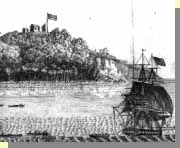
![[Previous]](prev.gif)
![[Next]](next.gif)

The roots of the colonization movement date back to various plans first proposed in the eighteenth century. From the start, colonization of free blacks in Africa was an issue on which both whites and blacks were divided. Some blacks supported emigration because they thought that black Americans would never receive justice in the United States. Others believed African-Americans should remain in the United States to fight against slavery and for full legal rights as American citizens. Some whites saw colonization as a way of ridding the nation of blacks, while others believed black Americans would be happier in Africa, where they could live free of racial discrimination. Still others believed black American colonists could play a central role in Christianizing and civilizing Africa.
The American Colonization Society (ACS) was formed in 1817 to send free African-Americans to Africa as an alternative to emancipation in the United States. In 1822, the society established on the west coast of Africa a colony that in 1847 became the independent nation of Liberia. By 1867, the society had sent more than 13,000 emigrants.
Beginning in the 1830s, the society was harshly attacked by abolitionists, who tried to discredit colonization as a slaveholder's scheme. And, after the Civil War, when many blacks wanted to go to Liberia, financial support for colonization had waned. During its later years the society focussed on educational and missionary efforts in Liberia rather than emigration.
In 1913 and at its dissolution in 1964, the society donated its records to the Library of Congress. The material contains a wealth of information about the foundation of the society, its role in establishing Liberia, efforts to manage and defend the colony, fund-raising, recruitment of settlers, and the way in which black settlers built and led the new nation.
Moreover, opportunities exist for additional research on the collection. For example, map study could reveal new data about settlement patterns, land ownership, and community development in Liberia. Work on the photographs could lead to identification of more of the individuals, locations, and events depicted. From passenger lists and land grants, researchers could glean new knowledge about Liberian genealogy. And, although the early history of the society has been well presented in publications, the post- Civil War period has not been thoroughly examined.
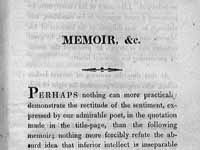
A Black Colonizationist |
Paul Cuffee (1759-1817), a successful Quaker shipowner of African-
American and Native American ancestry, advocated settling freed
American slaves in Africa. He gained support from the British
government, free black leaders in the United States, and members of
Congress for a plan to take emigrants to the British colony of
Sierra Leone. Cuffee intended to make one voyage per year, taking
settlers and bringing back valuable cargoes. In 1816, at his own
expense, Captain Cuffee took thirty-eight American blacks to
Freetown, Sierra Leone, but his death in 1817 ended further
ventures.
However, Cuffee had reached a large audience with his pro-colonization arguments and laid the groundwork for later organizations such as the American Colonization Society. Memoir of Captain Paul Cuffee, A Man of Colour: To Which is Subjoined The Epistle of the Society of Sierra Leone in African & etc., title page York: W. Alexander, 1812 [1817] Rare Book and Special Collections Division (1) |
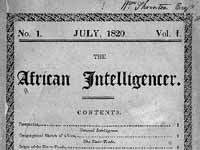
First American Colonization Society Journal |
In July 1820, the ACS published The African Intelligencer, edited
by Jehudi Ashmun (1794-1828), a young teacher who hoped to become
a missionary to Africa. Its thirty-two pages contained articles on
the slave trade, African geography, the expedition of the Elizabeth
(the ship that carried the first group of colonists to Liberia),
and the ACS constitution. Upset by the expense and the lack of
public support for the journal, ACS managers canceled the monthly
journal after one issue. Ashmun went to Africa in 1822, where he became an early leader of the Liberian colony before dying from a fever in 1828. This copy belonged to William Thornton, architect of the United States Capitol and a supporter of colonization. The African Intelligencer, vol. 1, no. 1, July 1820, title page Journal Rare Book and Special Collections Division (2) |
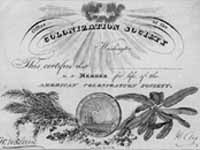
Life-Membership Certificate for ACS |
Selling life memberships was a standard fund-raising practice of
benevolent societies such as the American Colonization Society. At
thirty dollars each, the memberships were a popular gift for
ministers. In 1825, one of the agents who sold the certificates in
New England estimated that "not less than $50,000 have in this way
been poured into the treasury of the Lord." This certificate bears
a facsimile signature of Henry Clay, a founder of the ACS and its
strong advocate in Congress. Clay succeeded former president James
Madison as president of the society, serving from 1836 to 1849. [Life Membership Certificate for American Colonization Society], ca. 1840 Certificate American Colonization Society Papers Manuscript Division (3) |
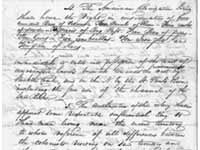
Treaty between ACS and African Kings |
Jehudi Ashmun envisioned an American empire in Africa. During 1825
and 1826, Ashmun took steps to lease, annex, or buy tribal lands
along the coast and on major rivers leading inland. Like his
predecessor Lt. Robert Stockton, who in 1821 persuaded African King
Peter to sell Cape Montserado (or Mesurado) by pointing a pistol at his head,
Ashmun was prepared to use force to extend the colony's territory.
His aggressive actions quickly increased Liberia's power over its
neighbors. In this treaty of May 1825, King Peter and other native
kings agreed to sell land in return for 500 bars of tobacco, three
barrels of rum, five casks of powder, five umbrellas, ten iron
posts, and ten pairs of shoes, among other items. [Treaty between American Colonization Society and African Kings], May 11, 1825 Holograph American Colonization Society Collection Manuscript Division (4) |
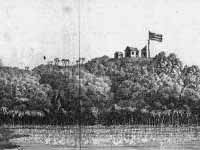
Second ACS Journal |
In March 1825, the ACS began a quarterly, The African Repository
and Colonial Journal, edited by Ralph Randolph Gurley (1797-1872),
who headed the Society until 1844. Conceived as the society's
propaganda organ, the journal promoted both colonization and
Liberia. Among the items printed were articles about Africa,
letters of praise, official dispatches stressing the prosperity and
steady growth of the colony, information about emigrants, and lists
of donors. This issue shows the first Liberian settlement at Cape
Montserado (or Mesurado), which became the capital city, Monrovia. The African Repository and Colonial Journal, vol. 1, no. 4, June 1825, p. 129 Journal Rare Book and Special Collections Division (5) |
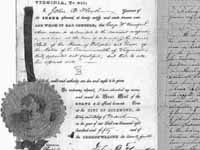
Virginia Legislature Supports ACS |
For many years the ACS tried to persuade the United States Congress
to appropriate funds to send colonists to Liberia. Although Henry
Clay led the campaign, it failed. The society did, however, succeed
in its appeals to some state legislatures. In 1850, Virginia set
aside $30,000 annually for five years to aid and support emigration.
In its Thirty-Fourth Annual Report, the society acclaimed the news
as "a great Moral demonstration of the propriety and necessity of
state action!" During the 1850s, the society also received several
thousand dollars from the New Jersey, Pennsylvania, Missouri, and
Maryland legislatures. [Act by State of Virginia making appropriations for removal of free persons of color to Liberia], 1850 American Colonization Society Papers Manuscript Division (7) |

Information for Emigrants |
During the 1830s, William Lloyd Garrison's violent condemnations of
colonization as a slaveholder's plot to perpetuate slavery created
deep hostility between abolitionists and colonizationists. Intended
to encourage emigration and answer anti-colonization propaganda,
the ACS pamphlet answers questions about household items needed in
Liberia, climate, education, health conditions, and other concerns
about the new country. Citing abolitionist charges that
colonizationists merely wanted "to get clear of the colored people
of the United States from their political and social disadvantages
. . . to place them in a country where they may enjoy the benefits
of free government . . . and to spread civilization, sound morals,
and true religion throughout Africa." Information About Going to Liberia: Things Which Every Emigrant Ought to Know. . ., title page Washington: American Colonization Society, 1848 Rare Book and Special Collections Division (8) |
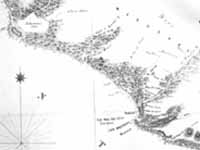
Map of Liberia |
By the 1840s, Liberia had become a financial burden on the ACS. In
addition, Liberia faced political threats, chiefly from Britain,
because it was neither a sovereign power nor a bona fide colony of
any sovereign nation. Because the United States refused to claim
sovereignty over Liberia, in 1846 the ACS ordered the Liberians to
proclaim their independence. This map of the newly independent
country shows the dates that the various territories were acquired.
Settlements were located primarily along the coast and the many
rivers leading inland. Inset maps highlight important areas of the
country. Republic of Liberia. Drawn under superintendence of Com. Lynch, USN, 1853 Map Geography and Map Division (9) |
Next section of the African-American Mosaic
Table of contents for the African-American Mosaic
 Library of Congress
Library of Congress